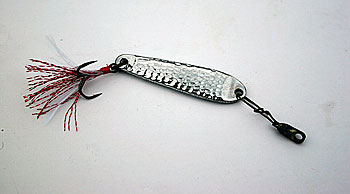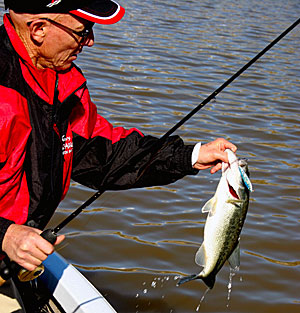
Almost everyone has a spoon or two in the tackle box. Those spoons gather dust for most of the year if you’re like most anglers. Maybe you’ll pull one out mid-winter and drop it a few times. However, these lures are typically forgotten. If you think of spoon fishing as a lift-and-drop operation, you’re underutilizing one of the most versatile lures. Spoons come in so many shapes and sizes because there are so many ways to fish this lure and so many different kinds of fish that will eat them. Stop missing out – dust off those spoons and give one of the below techniques a try.
-
Vertical jigging
This is probably the number one spoon technique most anglers think of when they find this lure in their tackle boxes. Spoons excel here – no other lure can give you the flash and flutter of a well-made spoon on the drop, and there isn’t a fish alive that resists a wounded-baitfish wobble.
Steve Foutch of Arizona is one angler who relishes the versatility of spoons. He knows that if you fish spoons where the fish are, you’re likely to lose a few baits, but he’s cashed so many tournament checks on spoon fish that he doesn’t mind the restocking fees. He mainly uses plain old dimpled metal slabs and buys the store brand from Bass Pro Shops. A hundred ¾-ounce and a hundred ½-ounce baits a year usually do it.
Years of spoon fishing have enabled Foutch to perfect his technique. He throws spoons on spinning gear with 8-pound-test line -- the spinning reel allows the bait to fall freely with a more natural action. “With a baitcaster, the line can’t keep up with the spoon, and you’ll see guys having to feed line out by hand,” he says. After experimenting with many different brands, he’s settled on Stren XT line. As for the reel, the most important thing is to have a genuinely excellent drag system.
Steve does a lot of vertical jigging in summer and winter. He casts the spoon out, lets it fall, then rips it back like a jerk bait. A spoon falls quickly – about a foot a second – so he counts it down until it is close to the bottom, then begins his retrieve. If you watch him, he closes the bail, then -- before he rips it, he shoves the rod forward about a foot. Then he rips it up almost straight over his head, takes up the slack, then rips it again.
The fish often take the bait on the fall, during that little pause, he lowers the rod and shoves it forward before swinging up on it again. Sunshine plays a big part in how well a spoon works. Sunlight is what gives a spoon its flash, so in the early morning or on a very cloudy day, another lure might work better. However, a spoon is hard to beat on a bright day in relatively clear water. On cloudy days Foutch will often try a white spoon before giving up on it completely.
“In the winter, the fishing is more vertical, so that’s when I switch to the heavier lure,” says Foutch. “You’ll just see the line go ‘ting’ – they take it on the fall.” Sometimes they slam it, but you get a little tick other times. He can catch a hundred fish daily if he gets on a really good spoon bite. He has also caught quite a few fish over ten pounds on spoons—most of those huge fish he has caught in the winter.
-
Swimming
Image
Flats are some of Steve’s favorite areas to fish. “I like flats with a bunch of cuts even if the difference in depth is only four or five feet,” he said. Sometimes the cuts are as subtle as two or three feet deep but still hold fish. Bass in weeds and submerged brush will also respond to spoons.
Swimming a spoon is the most effective presentation on flats or in shallow weeds and brush. In this case, think bowl of the spoon rather than the handle. Cupped spoons are available in weedless models for fishing through the thick stuff, but you can get away with a treble hook on an open flat. Cast your spoon to shore and pump it slightly as you reel it back. The pumping action will make the spoon wobble and dart and flash as it moves.
Swimming a spoon in shallow water requires either speed or a very light spoon. Bitin’ Titan Titanium Spoons are ideal for this application because they are incredibly light and have a large profile to attract big bass.
-
Trolling
Trolling can be the only way to put fish in the boat when fish are suspended or scattered along the bank or over channels. Spoons are great for trolling – almost no other lure will give you the flutter and flash that a spoon will, and they work well at any depth. You can control the depth by speed or by changing the size of the spoons, or you can use a downrigger.
If you’re not really into trolling, compromise: as you move to your next jigging spot, leave the spoon in the water and drag it with the trolling motor. Once you get bit this way, you’ll probably change your mind about trolling. Keep an eye on your graph. Watch for the thermocline and keep your spoon at that depth.
-
Popping
If Foutch sees fish surfacing, he casts the spoon past the boil and keeps the rod tip high. There’s no counting it down this time – he keeps the bait high and pops it back. This is a really exciting way to catch fish and much more reliable than topwater lures for boilers. The spoon resembles the shad the bass are after, and the way they drop and wobble between pops looks precisely like a dying baitfish. Steve often puts red hooks on his spoons to up the enticement factor.
-
Pitching
In cold water, the bass often hang out on steep vertical structure like bridge pilings, cliffs, and old submerged trees. Many fishermen pitch plastics on such structure, but there are times when a spoon is a better choice. Sometimes you have to force the fish to make snap decisions. A soft plastic bait moves slowly, giving the fish plenty of time to decide whether or not to bite, but a spoon will get away unless a fish takes it right now. Since bass are predators, most will opt to grab it before the chance is gone.
Again, you can change the rate of fall by choosing a different size or weight of spoon or by changing the line. Adding a trailer made from floating plastic will not only slow the lure down but will add movement to the flash and also allow you to add a bit of scent.
Make your initial pitch, then let the spoon flutter to the bottom. Try pulling it a bit to see if it will drop down another level. Once you catch a fish, pitch to that spot again – sometimes, an entire school of bass will be concentrated in a tiny area, especially in colder water.
All spoons all the time?

“I fish just like this at every lake,” he said. “It’s not on all the time at every lake, but you have to try it because when the spoon bite is on, you can get a limit in half an hour.” He starts pretty shallow early in the day, then moves out deeper as the sun gets higher. Steve says if you can see fish and you’re not getting bit – move out farther. A lot of times, that’s all it takes to entice bass to bite.
Spooning is tremendously reliable. Steve not only catches fish all year but also big fish. “Sixty percent of the fish I catch in tournaments come on spoons,” he said. He is often faced by scoffers, but they change their tune once they spend an hour or so in the boat with him. He constantly has to give spoons to his buddies and his partners.
More spoon tips
Watch the bank for clues to the bottom. Cuts that run into the lake may continue far out under water. “Rocks are part of the equation, too,” Steve Foutch says. “Watch the graph: there will be so many fish under you that it will turn black. People think that it is showing trees, but it’s fish.”
If you get snagged, go right over it, and you can usually shake a spoon loose. The heavier the spoon, the more easily it frees itself.
Spoons tend to create line twists, so always use a swivel. A snap can make it easy to change lures, but beware – those snaps also make you forget to re-tie as often as you should, and the result can be a snapped line when the big one bites.
A single hook snags less than a treble but still catches fish. If you take off the treble hook and put on a little drop-shot hook with more of a C-shape, it will snag even less.
If you fish a lot of timber, try simply flattening out the barbs on your hooks. With no barb, getting the hook free from the wet wood will be much easier. Using a heavier, slab-type spoon is best because the weight of the spoon itself helps lever the hooks free.
When fishing over a weed bed, opt for braided line. Braid is the line of choice for weed fishing because it’s strong enough to rip a bait free from snags. There’s a bonus, too – when you rip the spoon loose, don’t reel it back in immediately. Let it flutter down; you might get bit right then and there.




